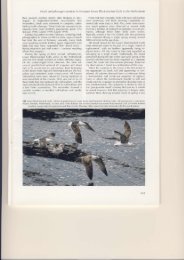Identification of American Herring Gull in a western European context
Identification of American Herring Gull in a western European context
Identification of American Herring Gull in a western European context
Create successful ePaper yourself
Turn your PDF publications into a flip-book with our unique Google optimized e-Paper software.
<strong>Identification</strong> <strong>of</strong> <strong>American</strong> <strong>Herr<strong>in</strong>g</strong> <strong>Gull</strong> <strong>in</strong> a <strong>western</strong> <strong>European</strong> <strong>context</strong>birds identified as smithsonianus present at Cobhthat w<strong>in</strong>ter and caused quite a bit <strong>of</strong> debatewhen it was first observed due to its ratherstreaked underparts and overall similarity tosome argentatus types. David Sibley exam<strong>in</strong>edimages <strong>of</strong> this bird and commented that, whenhe was based at Cape May, New Jersey, hewould see a very small number <strong>of</strong> similar-look<strong>in</strong>gbirds but that they did not appear there beforeNovember. The late arrival <strong>of</strong> these birds andtheir tendency to reta<strong>in</strong> juvenile plumage well<strong>in</strong>to the w<strong>in</strong>ter suggests a northerly orig<strong>in</strong>.Interest<strong>in</strong>gly, we did not f<strong>in</strong>d any that were clearly<strong>of</strong> this type <strong>in</strong> Massachusetts <strong>in</strong> January-February; David Sibley (pers comm) considersthis type to be much more frequent <strong>in</strong> Californiathan anywhere <strong>in</strong> eastern North America.Apart from the Cobh juvenile, and another juvenile<strong>in</strong> Galway <strong>in</strong> December 2000, all <strong>of</strong> thesmithsonianus we have studied <strong>in</strong> Ireland havecorresponded well with the more dist<strong>in</strong>ctive‘Atlantic coast type’ we are familiar with throughobservations <strong>in</strong> New Jersey and Massachusetts(plate 27). At the risk <strong>of</strong> exaggerat<strong>in</strong>g a problemwhich we have not had the opportunity to fully<strong>in</strong>vestigate ourselves (due to the absence <strong>of</strong> socalled‘high-latitude’-type smithsonianus <strong>in</strong> theparts <strong>of</strong> North America we have visited), werecommend particular caution be exercisedwhen identify<strong>in</strong>g juvenile smithsonianus <strong>in</strong>Europe. We have noticed a disturb<strong>in</strong>g similaritybetween several putative smithsonianus photographed<strong>in</strong> Europe, <strong>in</strong>clud<strong>in</strong>g the Cobh juvenile,and some perplex<strong>in</strong>g first-year herr<strong>in</strong>g gulls, possiblyhybrids, observed <strong>in</strong> Iceland <strong>in</strong> March2003.Hav<strong>in</strong>g said that, we suggest that critical assessment<strong>of</strong> the follow<strong>in</strong>g characters should helpresolve the identification <strong>of</strong> any suspected juvenilesmithsonianus <strong>in</strong> Europe.Tail pattern An ‘all-dark’ tail is popularly regarded asthe most essential attribute <strong>of</strong> any candidate first-yearsmithsonianus <strong>in</strong> Europe and birds possess<strong>in</strong>g one areusually among the most easily identified <strong>in</strong>dividuals.Three th<strong>in</strong>gs must be emphasized here however: 1 only16 <strong>European</strong> <strong>Herr<strong>in</strong>g</strong> <strong>Gull</strong> / Zilvermeeuw Larus argentatus argentatus, juvenile moult<strong>in</strong>g to first-w<strong>in</strong>ter, Byparken,Bergen, Norway, 20 January 2001 (Frode Falkenberg). Another very dark bird, with very limited pale fr<strong>in</strong>ges to tertials,similar to some juvenile <strong>American</strong> <strong>Herr<strong>in</strong>g</strong> <strong>Gull</strong>s L smithsonianus. This bird was r<strong>in</strong>ged <strong>in</strong> Bergen, already fully grown.It would be <strong>in</strong>terest<strong>in</strong>g to know if there is a particular geographical source <strong>of</strong> birds that look like this, and whetherthey develop <strong>in</strong>to perfectly normal-look<strong>in</strong>g adults?17 Lesser Black-backed <strong>Gull</strong> / Kle<strong>in</strong>e Mantelmeeuw Larus fuscus graellsii, juvenile moult<strong>in</strong>g to first-w<strong>in</strong>ter, Galway,Ireland, 28 December 2003 (Pat Lonergan). Overall darkness <strong>of</strong> body and w<strong>in</strong>gs, comb<strong>in</strong>ed with pale head, createsuperficial similarity to first-year <strong>American</strong> <strong>Herr<strong>in</strong>g</strong> <strong>Gull</strong> L smithsonianus, but such an appearance is not unusual <strong>in</strong>Lesser Black-backed <strong>Gull</strong>. Although underparts are undoubtedly dark, they are not as uniform as <strong>in</strong> most first-yearsmithsonianus.18-19 Unidentified gull / meeuw Larus, possibly a hybrid, juvenile/first-w<strong>in</strong>ter, Reykjanes pen<strong>in</strong>sula, Iceland,17 March 2003 (Killian Mullarney). One <strong>of</strong> several odd-look<strong>in</strong>g herr<strong>in</strong>g gull-types encountered <strong>in</strong> Iceland. Not as darkas bird <strong>in</strong> plate 20, this bird too looked dist<strong>in</strong>ctly odd. Large size, extensive retention <strong>of</strong> juvenile scapulars,rather bold uppertail-covert barr<strong>in</strong>g and overall demeanour unlike <strong>European</strong> <strong>Herr<strong>in</strong>g</strong> <strong>Gull</strong> Larus argentatus argenteus.Possibly hybrid Glaucous L hyperboreus x argenteus, maybe even some <strong>American</strong> <strong>Herr<strong>in</strong>g</strong> <strong>Gull</strong> L smithsonianus <strong>in</strong>fluence?20 Unidentified gull / meeuw Larus, possibly a hybrid, juvenile/first-w<strong>in</strong>ter, Reykjanes pen<strong>in</strong>sula, Iceland,17 March 2003 (Killian Mullarney). Another odd-look<strong>in</strong>g herr<strong>in</strong>g gull-type encountered <strong>in</strong> Iceland, a darker bird than<strong>in</strong> plate 18-19. Large size, overall darkness and somewhat Glaucous <strong>Gull</strong> L hyperboreus-like bill rem<strong>in</strong>iscent <strong>of</strong><strong>American</strong> <strong>Herr<strong>in</strong>g</strong> <strong>Gull</strong> L smithsonianus, but tail pattern and upper- and undertail-coverts pattern unconv<strong>in</strong>c<strong>in</strong>g forsmithsonianus. Possibly hybrid Glaucous x <strong>European</strong> <strong>Herr<strong>in</strong>g</strong> <strong>Gull</strong> L argentatus argenteus, maybe even some smithsonianus<strong>in</strong>fluence?21 <strong>European</strong> <strong>Herr<strong>in</strong>g</strong> <strong>Gull</strong> / Zilvermeeuw Larus argentatus argentatus, first-w<strong>in</strong>ter, Turku, F<strong>in</strong>land, 18 December 2003(Harry Lehto). Unusually dark-bodied bird, which might be mistaken for <strong>American</strong> <strong>Herr<strong>in</strong>g</strong> <strong>Gull</strong> L smithsonianus atfirst glance. Rather dark greyish second generation scapulars typical <strong>of</strong> F<strong>in</strong>nish <strong>Herr<strong>in</strong>g</strong> <strong>Gull</strong>s, and <strong>in</strong>vite confusionwith Lesser Black-backed <strong>Gull</strong> Larus fuscus graellsii. Note comparatively narrow dark bars on undertail-coverts.22 <strong>European</strong> <strong>Herr<strong>in</strong>g</strong> <strong>Gull</strong> / Zilvermeeuw Larus argentatus argentatus, juvenile, Tampere, F<strong>in</strong>land, 16 August 2003(Visa Rauste). Observers whose only experience <strong>of</strong> juvenile <strong>Herr<strong>in</strong>g</strong> <strong>Gull</strong> is with argenteus may have difficulty believ<strong>in</strong>ga bird like this could ever be a <strong>Herr<strong>in</strong>g</strong> <strong>Gull</strong>, and <strong>in</strong>sist that it is a Lesser Black-backed <strong>Gull</strong> Larus fuscus! In fact, itis not at all exceptional for juvenile F<strong>in</strong>nish argentatus to have such restricted pale tertial-fr<strong>in</strong>ges and virtually no‘notch<strong>in</strong>g’ <strong>in</strong> the feathers <strong>of</strong> the upperparts; such dark examples as this one (and the bird <strong>in</strong> plate 16) are, however,unusual.23 <strong>European</strong> <strong>Herr<strong>in</strong>g</strong> <strong>Gull</strong> / Zilvermeeuw Larus argentatus (argenteus?), juvenile, Wijster, Drenthe, Netherlands,23 January 2000 (Rudy Offere<strong>in</strong>s). Portrait <strong>of</strong> still juvenile-plumaged <strong>European</strong> <strong>Herr<strong>in</strong>g</strong> <strong>Gull</strong>, probably <strong>of</strong> argentatus stock.Compare with plate 11 and 20. It would be <strong>in</strong>terest<strong>in</strong>g to identify the geographical source <strong>of</strong> birds that look like this.9










